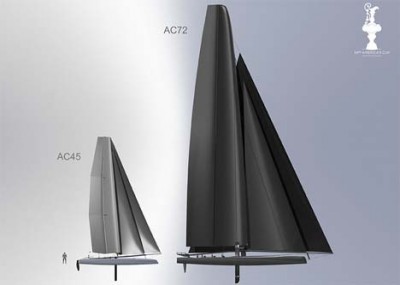 What can we say? The announced new Americas Cup class is a fact. We are going multihull! The newly announced rules will take the Americas Cup into a new era. The event is finally turning a much required corner which it should have taken some years ago. Not only should the new format be more exciting to both sailors and audience, it also should lead to a better level playing field and make it easier for competitors to access. With some of the biggest changes in Americas Cup history, the organizers have taken a bold step forward. It is now up to the sailors to prove them right!
What can we say? The announced new Americas Cup class is a fact. We are going multihull! The newly announced rules will take the Americas Cup into a new era. The event is finally turning a much required corner which it should have taken some years ago. Not only should the new format be more exciting to both sailors and audience, it also should lead to a better level playing field and make it easier for competitors to access. With some of the biggest changes in Americas Cup history, the organizers have taken a bold step forward. It is now up to the sailors to prove them right!
In presenting a new format for one of the world´s oldest and most famous events, the Americas Cup, Russell Coutts and friends are taking the Cup to the next level. The introduced changes are not only introducing a new boat class for the best sailors in the world, they also should create increased fairness, excitement and sustainability, values which are essential in going forward. We will briefly discuss the introduced changes and their effects.
New spectacular boat class and new annual world series should bring back the fun again! Reflecting on the 33rd Americas Cup a few thoughts come to mind. Firstly and for all, “let’s not have that one again!” As a result of all the legal disputes the Americas Cup lost credibility and appeal and hence was facing a big danger. Having said so, everybody interested in sailing was in awe when seeing the gigantic and enormously expensive multihulls in battle with each other. A third reflection was that everybody regretted the fact that there were no world series (like in the 32nd AC) in the build-up to “Let’s create a class and world series that are fair and spectacular” and this is exactly what they did. Let’s first look at the boat class: a new exciting class of boat is introduced, the AC72 wingsail catamaran, which will be raced from 2012. Simultaneously a scaled down version, the AC45 will also be build, which will be raced from next year onwards and will provide a fast-track for competitors in wingsail technology. The AC72 will be spectacular; with a length of 72 foot, width of 46 feet and with a wingsail of 130 feet high this beast should reach speeds in excess of 30 knots, making it the fastest boat class in the world. As these boats will not be easy to sail this also means that only the best (most fit, strong agile and multitasking) sailors in the world will be able to sail these boats…..and….no automated winches. Hence this should guarantee that the AC will once again be the pinnacle of sailing; the fastest cutting edge technology boats with the best sailors on it!
Let’s now turn to the world series which will be organized into the run up towards the Americas Cup and which will be mandatory. They will start in 2011 on AC45’s and will be a combination of fleet and match racing, whilst each year an Americas Cup World Champion will be crowned. This should bring back the buzz we witnessed during former America’s Cup events and as importantly improve the connection with fans.
New rules create improved fairness and improved level playing field. We all know what happened during the last Americas Cup. The defender of the cup did define the rules and sadly this resulted in disputes and an uneven level playing field, which severely hurt the credibility of the event. This will not happen again. The future Regatta Director will be part of an independent organization (thank god, no more disputes) and will be appointed jointly by the Challenger and Defender. Hence the Defender has forfeited some of the rights traditionally enjoyed by the holder of the trophy in the interest of making the competition more balanced and fair. Additionally majority approval of the competitors is required to amend the Protocol. Adding an independent jury and a well defined protocol of the 34th Americas Cup with few loopholes at first glance (however undoubtedly a few will pop up) and we have a much better base to start off from.
New format guarantees excitement. No doubt the new format should be fun. Races will be shorter, faster and furious, which should be fun to watch. But it is not only the boats and future world series that will create excitement, there are lots of other elements that will be introduced to make the event more attractive. Firstly race delays will be minimized due to the new boat (which can sail with low wind speeds) and reliable venues. Secondly for the first time onboard cameramen will be onboard of the competing yachts whilst tracking technology will also play an important role, both should add to the fun and experience. Thirdly it will be investigated how to better explain all the rules to a broader audience. Moreover geostationary spectator boats may replace the traditional buoys. Fourthly, the experience will be leveraged through the internet (one global website for all team and racing content, games etc). These elements should attract a younger crowd and create excitement. Russel Coutts phrased it right: let’s say farewell to the Flinstone generation and welcome the facebook generation, which also explains the move to multihull. He is right. It is clear! We are finally moving from the 20th to the 21st century and are reconnecting…….The youth forms the future and if no changes are being made, the Americas Cup will face the end rather sooner than later. This is also why a new youth Americas Cup will be introduced. It also means that the “older generation” should adjust and be willing to sacrifice; no matter what, they should not fear, they will be around for some time as some of them are still amongst the best sailors of the world and I am sure in the end they all will enjoy it as much as anybody else. As far as I am concerned that should finish the monohull-multihull dispute!
Lower costs, better returns means improved sustainability! The last Americas Cup has been far too expensive as far as costs are concerned. If this would go on, this cost spiral would severely limit the interest in participating and hence reduce the attraction of the race. Hence the organization has taken measures to reduce cost levels. For example on-board crew is being reduced from 17 to 11 (remember personnel cost account for 60% of a campaign), testing periods are being reduced, there will be limits as far as the number of sails, support boats and weather stations is concerned, etc, etc. Moreover the choice for multihull rather than monohull also turns out 20% cheaper (lower draft, logistic costs etc). All in all the costs for teams will range from EUR 40mln for a small team with a reasonable competitive profile to EUR 100mln for a big team. That makes this thing cheaper than some of the campaigns of the 32nd Americas Cup. All of this should raise the appetite of current and prospective teams. There are already some teams that want to buy the AC45 and a number of 8 challengers should not be out of reach, whilst rumors have it that at least one other American team will challenge the Defender BMW Oracle. Can’t wait for it!
So what about the returns? No doubt the last Americas Cup did not bring sponsors what they had hoped for. In contrast the legal battle between the teams resulted in some negative publicity. This time they should get a better deal for their money; branding freedom, more competitors, increased high adrenaline competition, a world series of races rather than a 3 day event, on board cameras, better spectator possibilities, reconnection to the younger generation and lower costs. The math is simple; lower cost and better exposure means higher returns. Adding the bigger fan-base this should not only be good for sponsors, it should also help the long term future and sustainability of the Americas Cup! Lets sail!
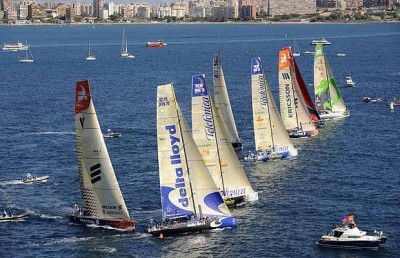
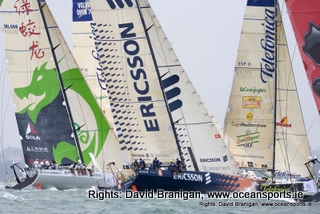
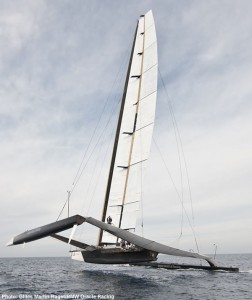 Looking back at the 33rd edition of the Americas Cup, the conclusion is one of mixed feelings. In disgust over the countless courtcases, fights, manipulation, postponements and enormous egos of the two owners of both syndicates. In awe of watching the magnificent display of technology and raw power of the BMW Oracle and to a less extent Alinghi. And full of enthusiasm when watching the actual race. That pretty much sums it up. Clearly, awe and enthusiasm have taken the upper hand during the last week. In that perspective it is sad to conclude that the 33rd Americas Cup will likely end up in the history books as one of the most controversial ones, very similar to the Americas Cup of 1988, when Dennis Connor won the cup with his Stars and Stripes. It is to hope that, again similar to what happened after1988, the 34th Americas Cup will regain some of its lost reputation, a big responsibility for the parties involved.
Looking back at the 33rd edition of the Americas Cup, the conclusion is one of mixed feelings. In disgust over the countless courtcases, fights, manipulation, postponements and enormous egos of the two owners of both syndicates. In awe of watching the magnificent display of technology and raw power of the BMW Oracle and to a less extent Alinghi. And full of enthusiasm when watching the actual race. That pretty much sums it up. Clearly, awe and enthusiasm have taken the upper hand during the last week. In that perspective it is sad to conclude that the 33rd Americas Cup will likely end up in the history books as one of the most controversial ones, very similar to the Americas Cup of 1988, when Dennis Connor won the cup with his Stars and Stripes. It is to hope that, again similar to what happened after1988, the 34th Americas Cup will regain some of its lost reputation, a big responsibility for the parties involved.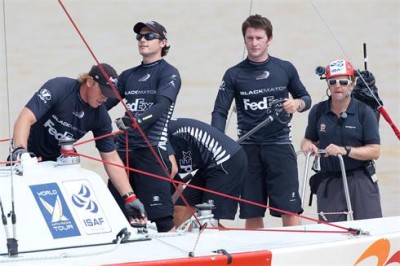 This weekend Adam Minoprio and his ETNZ/Blackmatch Racing crew were crowned as the new world champions of the ISAF World Match Racing Championships series, winning the Monsoon Cup in Malaysia, the last race of the circuit. The finals were telecasted live and clearly demonstrated that matchracing is fun to watch and very suitable for television in contrast with for example fleet racing. With modern on board coverage and back-up graphic tools, the viewer is enjoying a live-man-to-man yachting experience. Adding the fact that match racing in the WMRC format should be attractive for sponsors spectators and cities and taking into account the growth of the sports, I believe match racing has a great future ahead.
This weekend Adam Minoprio and his ETNZ/Blackmatch Racing crew were crowned as the new world champions of the ISAF World Match Racing Championships series, winning the Monsoon Cup in Malaysia, the last race of the circuit. The finals were telecasted live and clearly demonstrated that matchracing is fun to watch and very suitable for television in contrast with for example fleet racing. With modern on board coverage and back-up graphic tools, the viewer is enjoying a live-man-to-man yachting experience. Adding the fact that match racing in the WMRC format should be attractive for sponsors spectators and cities and taking into account the growth of the sports, I believe match racing has a great future ahead.